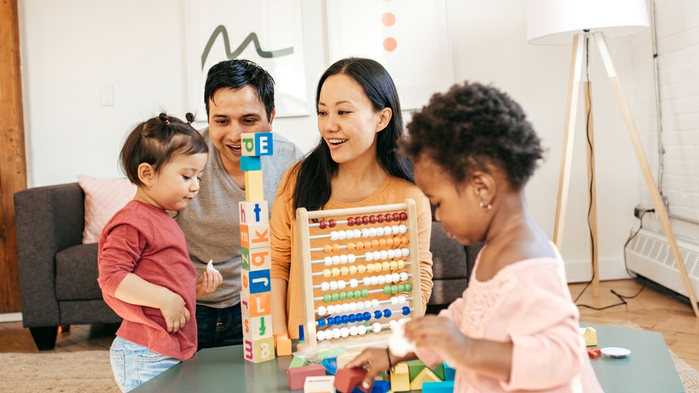Toddlers come in all shapes and sizes, but development during these years typically has a few things in common. Dr. Amy Morgan , a pediatrician with Novant Health Highland Creek Pediatrics, highlights some crucial milestones that children will hit between the ages of one and three.
What should my toddler be eating?
“For the first year of life, it’s formula and breast milk,” Morgan said. “Once they get into the toddler years, children develop a palate. I try to encourage parents to broaden that palate and not just give their child french fries and mac and cheese.”
Morgan cautions parents against giving their children foods that are heavily salted, buttered or sweetened. These flavors can decrease their willingness to eat “yucky” healthy foods. No sugary drinks, either. The American Academy of Pediatrics recommends no juice for children under the age of one, but even after a child’s first birthday, opt to give your child water and milk instead.
“When you offer a child in this age group a new food, they might make faces and try to push it away,” Morgan said. “You’ll have to introduce certain foods a few times before they start accepting it and learn to enjoy it.”
Morgan recommends the 5:2:1:0 rule to her families: 5 fruits and vegetables a day, no more than 2 hours of screen time, at least 1 hour of physical activity and 0 sugary drinks, including juice.
How much sleep does my toddler need?
Children need good sleep to ensure a healthy development. A consistent bedtime routine helps your child transition from their busy day to restful sleep. Establishing a routine and sticking to it is the foundation needed to create healthy sleep patterns for your toddler.
“What children learn and absorb during the toddler years is unbelievable,” Morgan says. “Sleep is when all of those things are consolidated into their memory. It’s also when the growth hormone is produced.”
Your toddler should be getting between 10 and 12 hours of sleep a night and a nap or two during the day, Morgan said. . When it comes to sleep safety, blankets, pillows and stuffed animals no longer pose the risk of SIDS (sudden infant death syndrome) that they did when your child was an infant, so it’s okay to let your little one hang on to their teddy bear when it’s bedtime.
“We’re much more liberal letting this age group sleep with their favorite blanket or teddy,” Morgan said. . “When kids wake up in the middle of the night, they need to learn how to soothe themselves back to sleep without needing mommy or daddy. A security object can provide that comfort.”
What milestones will my toddler hit and when?
Between 12 and 36 months, toddlers are doing a lot of things for the first time, but they’re making the biggest strides in learning how to communicate, Morgan said.
“Of all the developmental skills and milestones that a child experiences between 12 and 36 months, motor skills and language development is probably the biggest,” Morgan says. “The development that happens between ages one and three is pretty profound.”
By their first birthday, most children are waving, shaking their heads and trying to mimic what others are saying and doing. Your one-year-old is also learning how to sit and stand on their own, and soon enough they’ll be taking their first steps. A two-year-old can put together simple two word phrases such as “want shoe,” or “go outside!”
Concerned that your child isn’t walking as early as his or her peers? Don’t be. “With each individual benchmark, there’s a wide age variation,” Morgan reminds parents. “We see some nine-month-olds that are walking and some who walk at 15 months. A delay in one area is not necessarily cause for concern.”
“That’s one of the main reasons to go to the pediatrician,” Morgan said. “We know where the bell curve is. If we see that a child is not walking at 15 months, I’ll be able to put that into context with how well they’re doing with other milestones.”
By age three, your child will begin to name familiar things, play with their peers, and carry on conversations with others using longer sentences. Emotionally, your toddler will experience a wide range of emotions and may react negatively to change that disrupts their routine.
When should I start potty training?
“Frequently my advice is that the more of a battle you make potty training with your child, the more they resist,” Morgan said.
Regardless of age, your child must be both physically and emotionally ready for toilet training. Many parents begin the process after their child’s second birthday, but every child is different. Generally speaking, girls tend to be ready for potty training earlier than boys.
“Some children have a fear associated with using the toilet, so they hold it in,” Morgan says. “Parents have to offer reassurance and make sure they’re getting enough fruits and the proper foods to keep their stool loose so they can only hold it in for so long.”
Avoid power struggles and provide positive reinforcement when your child expresses interest in using the toilet. If potty training becomes a nightmare, Morgan recommends easing up. There is no “magic age” for potty training, but rest assured, every child reaches a point of readiness.
How can I keep my toddler engaged?
“It’s never too early to begin reading to your child, engaging and having conversations with them,” Morgan said in closing. “In an increasingly digital world, we need to reinforce how important face to face, two-way communication is and not plop our children in front of the nearest screen.”
“Explore with your child. Go for a walk outside and pick up leaves and sticks; talk about them,” Morgan added. “This expands your child’s vocabulary and heightens their curiosity about the world around them. Encourage them to touch and feel things and to live in a world outside of a screen.”






